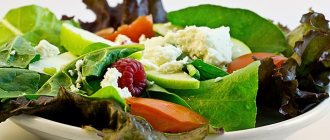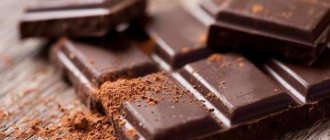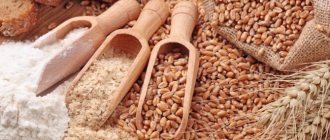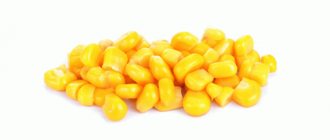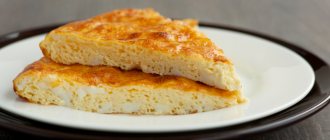In other cases, even patients with gastritis who are forced to follow a diet sometimes like to pamper themselves. Sweets fill you with energy, relieve stress, and improve your mood.
And sugar is not mentioned in the list of prohibited foods for gastritis. Let's talk about which sweet treats can be included in the diet if you have stomach problems, and which ones you should avoid.
What kind of sweets are there?
Sweets usually include all foods and dishes containing large amounts of sugar. These are sweets and confectionery, preserves, jams, marshmallows, chocolate, marmalade, marshmallows, etc. The category of sweets also includes prepared dishes - jellies, puddings, mousses, creams, fruit and berry desserts, cakes, pastries and much more. An example of a healthy natural sweetness is honey. A valuable beekeeping product, in addition to being a pleasure, also enriches the body with vitamins and microelements. Therefore, you can and should eat honey for gastritis, albeit in moderation and carefully.
From all the variety of delicacies, patients with gastritis should be able to choose those that will not harm the inflamed gastric mucosa.
The basis for the choice is the principles of dietary nutrition, the main goal of which is mechanical and chemical sparing of the gastric mucosa. To make your task easier, we have compiled tables that list permitted and prohibited sweets.
Table 1. For acute gastritis in the recovery stage, with exacerbation of chronic gastritis with normal and high acidity
| Allowed sweets | Forbidden sweets |
| Sugar, honey, sour jam | Ice cream |
| Mousses, jellies, sambucas, jelly from non-acidic fruits and berries | Chocolate |
| Pastila, marshmallow | Dried fruits |
| Meringues, butter cream | Sour fruits and berries |
Table 2. With a sharp exacerbation of the disease
| Allowed sweets | Forbidden sweets |
| Non-sour jelly, including milk | Any raw berries and fruits |
| Jelly | Any confectionery |
| Honey, sugar | Chocolate, candies, marshmallows, marshmallows |
Table 3. In remission, after a strict diet
| Allowed sweets | Forbidden sweets |
| Jelly, mousse, sambuca, jelly | Chocolate |
| Sugar, honey | Ice cream |
| Ripe sweet berries and soft fruits | Cream cakes and pastries |
| Pastille, marshmallows, marmalade | Dates, prunes |
| Creamy caramel, toffee | Any sweet baked goods |
| Meringues | |
| Jam, jam |
In general, we’ve got our bearings on the choice of sweets, now let’s move on to a more detailed consideration of sweet products.
Eating marshmallows for gastritis
Marshmallow is absolutely harmless for gastritis if eaten in moderation. It is not only an appetizing sweetness, but also benefits the body: The product does not contain fats; it is made from fruit purees, sugar, protein and thickeners identical to natural ones. Marshmallows made from applesauce are especially useful; this gives them the ability to cleanse the body and reduce hunger.
Due to its low calorie content, marshmallows will not lead to weight gain. This is especially important for people who tend to be overweight. The product contains phosphorus and iron, which increase immunity, as well as strengthen bones and joints, improve vision - all this is important not only in the presence of chronic diseases, but also for a healthy person. Due to pectin, the body is cleansed of toxic elements and toxins, the percentage of cholesterol in the blood is reduced several times, and a general strengthening of the weakened body occurs.
A thickener such as agar-agar saturates the body with calcium and iodine, which has a beneficial effect on the liver and cleanses it of harmful substances. Glucose activates brain activity, improves mood, and relieves stress. This delicacy has a light, airy taste; it does not create a feeling of heaviness in the stomach or burden it. The product helps the functioning of the gastrointestinal tract.
Marshmallow for exacerbation of gastritis
Marshmallow is even officially present as permitted in therapeutic diets, even during exacerbations of gastritis. During exacerbations of gastritis,
patients are allowed only a complex of low-fat meat products, as well as vegetable soups and fish dishes, lean meat and fish, and strong broths. Fruits and vegetables fried in butter or baked, cocoa, coffee, and juices are also allowed. As soon as the period of exacerbation is left behind, patients with gastritis are again allowed to switch to a normal, but gentle diet.
Experts are quite positive about including marshmallows in the diet for patients with gastritis. The fact is that it contains such a useful substance as pectin. Therefore, this product is even officially present, as permitted in therapeutic diets, and even during exacerbations of gastritis, the main thing is not to abuse it.
Marshmallow for rosative gastritis
Erosive gastritis is a type of chronic gastritis, a characteristic feature of which is the formation of erosions on the gastric mucosa. It develops as a result of alcohol and drug abuse, taking certain medications, and infection with pathogenic microorganisms. Erosive gastritis usually occurs against the background of preserved or increased acidity, so the patient is prescribed dietary treatment table No. 1. This diet also includes marshmallows.
Marshmallow is made from fruit and berry puree with the addition of proteins and jelly-forming components. Nutritionists recommend it to patients for any type of gastritis. The confectionery product in the form of hemispheres belongs to dietary nutrition; it does not cause heaviness in the stomach, does not irritate the mucous membranes, and stimulates the functioning of the brain. The Institute of Nutrition of the Russian Academy of Medical Sciences is recommended for young children.
Marshmallows, marmalade, marshmallows
Among sweet treats, marshmallows, marmalade and marshmallows are the “democrats”.
For any form of gastritis, nutritionists allow them to be consumed. But don’t think that you can eat half a kilo of marshmallows or marmalade in the evening - although treats are allowed, they are in small quantities, 2-4 pieces per day , no more.
And not in one go. Gastroenterologists favor these sweets due to many advantages:
- Easily absorbed and well digested.
- They are low-calorie foods.
- Contains natural ingredients - pectin, agar-agar, applesauce.
When purchasing, give preference to white sweets, without icing, sprinkles or other additives. Marmalade of bright colors is not your option, buy natural, one that “creases.”
Marshmallow for gastritis
If you are tormented by doubts whether marshmallows are good for gastritis, we hasten to reassure you. Doctors answer “Yes!”, but advise you to adhere to the basic rules of the diet. Marshmallow is the most affordable sweet for gastritis in particular. This is the lowest calorie sweet product. It contains an element useful for digestion - pectin, which has a beneficial effect on the gastrointestinal tract, activates the body's own microflora and accelerates the absorption of nutrients.
In addition, marshmallows do not leave a feeling of heaviness, which, coupled with the unpleasant sensations of gastritis, puts patients in the worst mood. This oriental sweet can be eaten both with low and high levels of stomach acidity. Thanks to this, doctors allow the consumption of marshmallows during a diet.
The “correct” marshmallow contains applesauce, which is beneficial for digestion. Therefore, this sweetness can be eaten with gastritis. When purchasing a product, pay attention to its composition and color. The white color of marshmallows may indicate the absence of dyes, preservatives and various substitutes in the composition.
Candies, chocolate
Chocolate and chocolate candies are not recommended for gastritis.
During the remission stage, you can allow yourself butterscotch, as well as creamy caramel in small quantities. Chocolate products are too high in calories and contain large amounts of butter. In chocolates, butter is often replaced with margarine, palm oil, etc., which makes the product harmful.
Important! It is better not to include chocolate in your diet if you have gastritis.
Caramel and toffee do not have as much fat, so they are lower in calories. As an addition to tea drinking, such sweets are quite suitable, but, again, in reasonable quantities.
Jam, jam, honey
Both jam and honey will help diversify your diet. You know how to use honey for gastritis, but jams and jams require additional discussion.
So, the basic requirements for jams and preserves:
- The product must be prepared from sweet fruits or berries. No acidic raw materials are used.
- Jams and preserves should not be stored for more than a year.
- Candied jams are strictly prohibited.
When it comes to different types of jam, use raspberry jam with caution.
Raspberries contain large amounts of acetylsalicylic acid. Also, the berry contains coarse grains. If you really want raspberries, make sweet fruit juice or jelly from them. In the process of squeezing the berries, get rid of scratching elements.
Strawberries, wild strawberries, blueberries, apricots, peaches, sweet apples, sea buckthorn are the optimal raw materials for making jam or jam for gastritis.
List of approved products
List of sweets allowed for hyperacid gastritis:
- mashed fruit puree;
- non-sour jams and jellies;
- puddings;
- fruit pastille;
- marshmallows and marmalade;
- butterscotch or caramel;
- milk or fruit based soufflé;
- casserole made from non-acidic, low-fat cottage cheese;
- cottage cheese pancakes baked in the oven;
- charlotte;
- baked apples;
- bananas;
- corn sticks;
- drying and long-lasting cookies (for example, “zoological”);
- fresh pureed non-acidic low-calorie cottage cheese with honey;
- honey, slightly diluted in milk, tea or water;
- melted ice cream (avoid frozen juices with high acid levels).
Lovers of sweet drinks should also be careful about their choice. Allowed drinks include:
- jelly (milk or oatmeal works well);
- juice (except for citrus fruits and other overly acidic juices);
- compotes from dried fruits (it is not advisable to consume dried fruits themselves, the only exception being raisins);
- dietary dairy products (yogurt, yogurt, milk). Kefir is not recommended for hyperacid gastritis;
- weak tea with milk;
- cocoa with milk;
- green or herbal tea (special active components of herbal teas, for example, anise or fireweed, can restore damaged gastric mucous membranes).
Ice cream, condensed milk
Ice cream is not recommended for gastritis. The only exceptions are fruit ice and soft natural milk ice cream (sofutu - kurimu).
Condensed milk (natural, without additives) can be consumed. It is not necessary to eat it with a spoon; it is better to add it to tea or water. You can flavor curd casseroles, porridges, and puddings with condensed milk, using it instead of sugar.
Boiled condensed milk is not suitable for patients with gastritis for a number of reasons:
- Does not contain useful substances;
- Has a higher calorie content compared to regular condensed milk;
- Has a solid consistency;
- Contains large amounts of preservatives.
Harm of marmalade
First of all, in this case, we need to again mention the low-quality raw materials and harmful additives used in the preparation of marmalade. They cause the greatest harm.
It must also be said that red flower marmalade, according to scientists, can lead to memory impairment, excessive activity and absent-mindedness.
So, is it still possible to eat marmalade if you have gastritis? However, and this is quite natural: you should not get carried away too much even with high-quality products - often the lack of moderation leads to bad consequences.
It all depends on the basis
Pectin
If, when choosing marmalade, you find the “E440” sign, don’t worry, in the food industry it means pectin, which is a substance of plant origin. It is a polysaccharide obtained by extracting pulp from apples and citrus fruits. Promotes the processes of gel formation and thickening. Pectin, which contains no proteins or fats at all, but only carbohydrates, is considered a product with the lowest calorie content.
Pectin is useful because it removes harmful substances and poisons from the body such as heavy metals, pesticides, and others. At the same time, it does not disrupt the system of beneficial bacteria, which means it does not disrupt metabolism. Normalizes blood circulation and intestinal functions. And yet, it eliminates inflammatory processes in the gastrointestinal tract, which means it helps treat gastritis.
But how invisible is the fine line between the beneficial and harmful properties of this product. If you consume it excessively, the balance of the intestinal microbial flora is disrupted, you will be tormented by the formation of gases, constant rumbling in the stomach and, most importantly, diarrhea. Frequent bowel movements interfere with the absorption of nutrients in the intestine, which will lead to disruption of metabolic processes.
Gelatin
The health benefits and harms of gelatin have been debated for a long time. The basis of gelatin is proteins and amino acids. It is extracted from collagen. For digestion, its benefits are invaluable in improving the functioning of the stomach and intestines and reducing their upset. Gelatin promotes a feeling of fullness without overeating.
If you use gelatin without excess, it will not cause harm to your health. However, there are contraindications for it too. Firstly, gelatin can cause allergies. When consumed in large quantities, it will lead to the formation of stones in the urinary system, and hypercoagulation may occur - increased blood clotting. That is, in this case we are talking about moderation in use.
Those who are completely contraindicated for gelatin are people suffering from diseases of the cardiovascular system.
Agar-agar
Carefully dried algae, turned into powder, are widely used throughout the world as an anti-inflammatory agent that destroys toxic substances found in the lumen of the intestines and stomach. Agar-agar has a very mild laxative effect. Its properties differ in many respects and favorably from ordinary gelatin. Perhaps it is the best means for making marmalade.
Marmalade - benefits and harm. Composition and calorie content of marmalade
To the cinema? So it's popcorn
The American habit of watching movies with a bag of popcorn has successfully taken root here too. Puffed corn has many beneficial properties: it is low in calories, rich in B vitamins, can remove toxins and is a preventative against cancer. This is provided that the product does not contain additives, dyes, or flavors.
For gastritis, sweet popcorn is allowed, however, if it is completely natural. You can’t be sure of an industrial product, so make your own popcorn, it’s not difficult.
Homemade Popcorn Recipe
Buy a package of natural corn kernels at the supermarket.
- When you get home, prepare a large microwave-safe bowl, put a small piece of butter in it, and melt it in the microwave.
- Pour the grains into a container, add a little sugar, stir and microwave for 3-4 minutes, no more.
Your sweet popcorn, approved for gastritis, is ready. And there is no doubt about the naturalness of the product.
Oriental sweets
Remember the saying, no matter how many times you repeat halva, halva will not taste sweet in your mouth?
And it really won’t, because halva is prohibited for gastritis. The structure of the product is heavy, the consistency is scratchy, and the calorie content is huge. Even for a person with a healthy stomach, the permissible amount of halva is limited to 30 grams per day - this is just one packaged bar.
Another oriental sweet, Turkish delight, is less traumatic for the mucous membrane. The consistency is similar to marmalade, and if the product is without additives, if you have gastritis, you can afford 2–3 pieces per day . The main ingredients of Turkish delight are water, sugar and starch, which are not contraindicated in the remission stage. But this does not apply to gastritis with high acidity, since starchy foods increase secretion.
Turkish delight with additives of candied fruits, nuts and flavorings is contraindicated for gastritis.
Homemade marmalade
In order not to look at small letters on store labels in search of information about the product, to be completely calm about its quality and safety, learn how to make marmalade at home. Fortunately, there are a lot of recipes for this, and there are plenty of ingredients, for example, greenish apples, which contain much more pectin than sweet fruits.
The entire cooking process should use 2 kg of apples, approximately 500 grams of sugar and 100 ml of clean water.
Peel large apple slices. Boil the fruit core in a saucepan with water for about half an hour until it becomes mushy. Grind this brew using a sieve and mix with chopped slices. Place half of the prepared sugar together with the apples in a saucepan and keep on the fire until the fruit is soft.
Then we pass the whole mass through a meat grinder and let it cook again, adding sugar, over low heat, stirring occasionally. This procedure will last about forty minutes. Then cool the liquid mass and place it on a baking sheet. The marmalade should harden for two days at room temperature. Then you cut it, giving the candies a shape based on your own imagination.
Making marmalade at home
Bon appetit!
Pies, pastries and cakes
Even if you really want sweets with gastritis, pastries, pastries and cakes are not for you.
An acceptable option is a simple sponge cake made with eggs, without additives. There are many recipes for making sponge cakes in a double boiler, which you probably have in your home. Try it, it’s not only tasty, but also absolutely safe for gastritis.
An alternative to cakes is meringues and snowball cakes. Excellent sweetness with a delicate, melting consistency. By the way, making meringues at home is also easy.
High acidity - be careful
Patients with gastritis with increased secretion are rarely capricious about certain food preferences. Any dietary liberties “beyond the diet” result in exacerbations, pain, and forced therapeutic fasting.
Sweets for such people are sweet jellies and mousses, compotes, jelly and fruit drinks. You need to be careful with other treats. If the remission is long, marshmallows and marshmallows, soft natural marmalade are allowed in very small quantities.
An alternative to industrial sweets should be homemade desserts, for example, banana-yogurt cream, whipped with a mixer or homemade popsicles. If you think about and take care of your health, you should contact a professional nutritionist. There are nutrition institutes in all major cities; specialists will develop a diet taking into account your disease and even take into account your food preferences. Friendship with a nutritionist for gastritis is very desirable, think about it.
Having chronic gastritis, you should not despair. The transition to proper nutrition is difficult during the first month. After the diet becomes habitual, exacerbations occur less frequently, or even disappear completely. Eat rationally, and when you want something sweet, remember this conversation and follow our advice.






